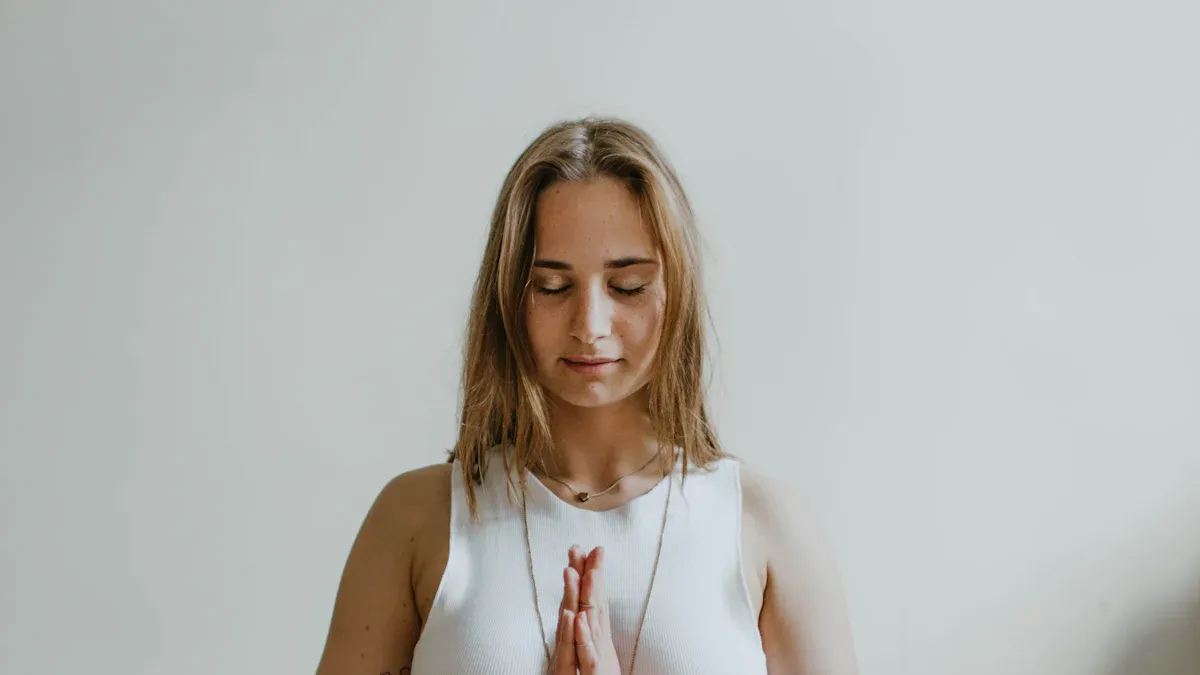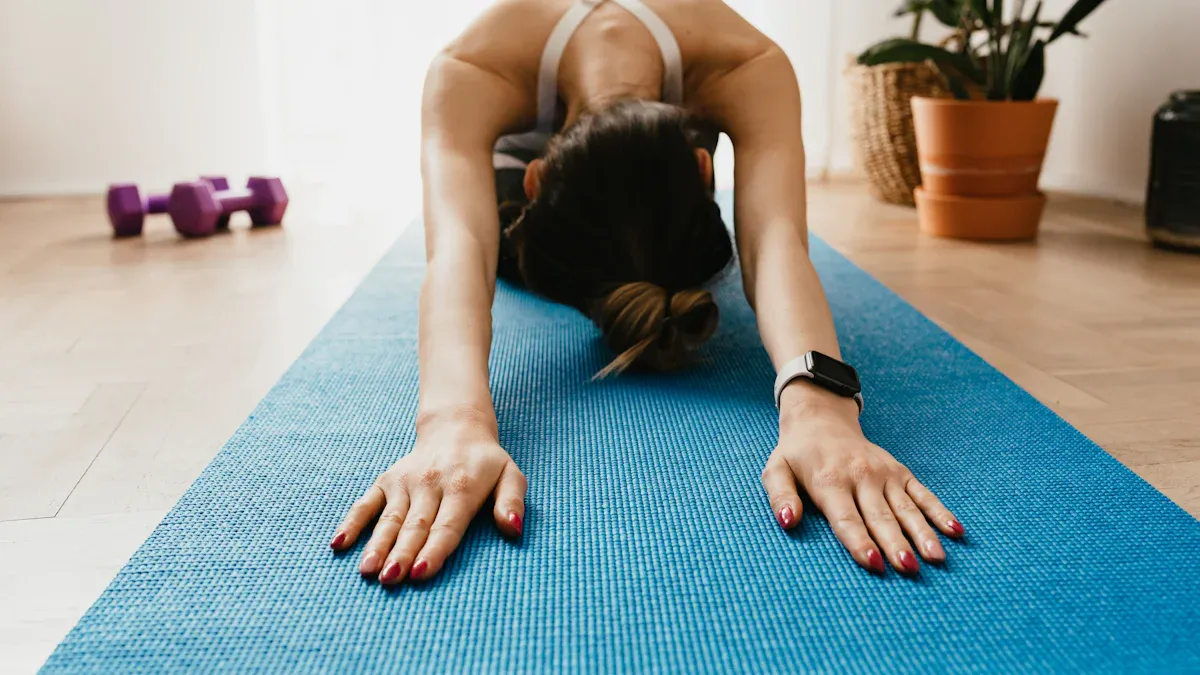How Beginners Can Use Yoga to Lower Cancer Risk

Can yoga really help lower your cancer risk, even if you’re just starting out? Yes, it can. Studies show that yoga improves how your body works and helps you feel less stressed, anxious, or tired. You don’t need to be flexible or fit to get these benefits. Picture yourself trying simple poses at home or in a class. Yoga helps you relax, sleep better, and boost your mood. Many doctors now recommend yoga for its safe, gentle support. You’ll find both body and mind feel better when you follow A Beginner's Guide to Yoga for Cancer Prevention.
Key Takeaways
Yoga helps reduce stress and improve mood, which supports your immune system and overall health.
You do not need to be flexible or fit to start yoga; simple poses and gentle styles work well for beginners.
Practicing yoga regularly can improve sleep, lower inflammation, and encourage healthy habits that may lower cancer risk.
Starting with short sessions and using props or modifications makes yoga safe and accessible for all ages and health levels.
Building a consistent yoga routine, even with just a few minutes a day, can boost your well-being and help protect your body.
Yoga and Cancer Risk

What the Research Shows
You might wonder if yoga can really lower your risk of cancer. Scientists have looked into this question. Right now, most studies focus on how yoga helps people who already have cancer. These studies show that yoga can make you feel less anxious, less tired, and less stressed. You may also notice better sleep and a brighter mood after practicing yoga.
Yoga helps manage stress, anxiety, and depression in people with cancer.
It can boost your immune system by lowering stress hormones.
Many people feel stronger and more hopeful after adding yoga to their routine.
Online yoga classes can also help reduce anxiety and depression, though results can vary.
Note: Most research looks at how yoga helps with symptoms, not at whether it stops cancer from starting. Scientists still need to do more studies to find out if yoga can directly lower your cancer risk.
Some animal studies suggest that stretching, like you do in yoga, might slow down tumor growth. Active yoga styles, such as vinyasa, share benefits with aerobic exercise. Aerobic exercise links to lower death rates from cancers like breast, colon, and prostate. This gives hope that yoga could help, too, but we need more proof.
Key Benefits for Prevention
Yoga may not have direct proof of stopping cancer, but it does offer many benefits that support your body’s defenses. When you practice yoga, you help your body in several important ways:
Yoga calms your mind and lowers stress. Less stress means your immune system works better.
It helps control hormones like cortisol, which can harm your body if levels stay high.
Yoga reduces inflammation by lowering chemicals in your body that cause swelling.
You improve your heart health and help your body handle stress better.
Yoga supports healthy habits, like better sleep and mindful eating.
Practicing yoga brings your mind and body together. You learn to breathe deeply, move gently, and relax fully. These changes can help your body fight off illness and may lower your risk for many diseases, including cancer.
Yoga Benefit | How It Helps Cancer Prevention |
|---|---|
Stress Reduction | Supports immune health |
Hormone Balance | |
Less Inflammation | Reduces risk factors for disease |
Better Heart Health | Improves body’s stress response |
Mind-Body Connection | Encourages healthy lifestyle choices |
You do not need to be an expert to get these benefits. Even simple yoga poses and breathing exercises can help you feel calmer and healthier. Over time, these small changes add up and may help protect you from cancer and other illnesses.
How Yoga Helps
Stress Reduction
Yoga gives you powerful tools to manage stress. When you practice yoga, you focus on your breath and gentle movements. This helps calm your mind and body. Many studies show that yoga lowers anxiety and improves sleep. You may notice you feel less tense and more relaxed after just a few sessions.
It helps balance hormones like cortisol, which can get too high when you feel stressed.
Lower stress means your immune system works better.
Chronic stress can raise blood sugar and cause inflammation, both linked to higher cancer risk.
Managing stress with yoga can help keep your body in balance.
A review of mindfulness-based programs, including yoga, found that most people felt less anxious and stressed. This can improve your quality of life and help your body fight off illness.
Immunity and Body Function
Yoga does more than help you relax. It also supports your immune system and keeps your body working well. When you move and stretch, you help your lymphatic system clear out waste and dead cells. This process helps your body stay healthy.
Yoga can:
Lower inflammation by changing how your body reacts to stress.
Improve blood flow and oxygen levels, which keeps your cells healthy.
Help your body balance important systems, like your nerves and hormones.
Boost immune cells that protect you from illness.
Yoga also helps you sleep better and feel more focused. These changes support your body’s natural defenses and may lower your risk for diseases, including cancer.
Weight and Well-Being
Keeping a healthy weight is important for lowering cancer risk. Yoga can help you manage your weight, especially when you practice regularly. Some people notice a smaller waist or less body fat after doing yoga for a few months. While yoga alone may not lead to big weight changes, it supports healthy habits and makes you more aware of your body.
Yoga & Weight | What Studies Show | Notes |
|---|---|---|
Waist size | Can decrease | More likely with regular practice |
Body fat | May go down | Results vary by person |
Weight | Often stable | Yoga helps maintain, not always lose weight |
Yoga also boosts your mood and emotional health. You feel more connected to your body and mind. This sense of well-being makes it easier to stick with healthy choices every day.
A Beginner's Guide to Yoga for Cancer Prevention

Choosing a Style
When you start with A Beginner's Guide to Yoga for Cancer Prevention, you want a style that feels safe and gentle. You do not need to push your body hard. Many experts suggest these beginner-friendly yoga styles:
Iyengar yoga: This style uses props like blocks and straps. You move slowly and focus on good body alignment. Instructors help you find the right form, so it works well if you have injuries or limited movement.
Yin yoga: You hold poses for a longer time. This helps you relax and stretch deeply. Yin yoga is slow and calming.
Gentle or restorative yoga: These classes focus on breathing, mindfulness, and easy movements. You can relax and let your body rest.
Avoid fast or intense styles like Power or HIIT yoga until you feel ready or have a teacher to guide you.
Tip: Look for classes that mention relaxation, breathing, or mindfulness. These support your body and mind as you follow A Beginner's Guide to Yoga for Cancer Prevention.
Simple Poses to Start
You do not need to twist into a pretzel to get benefits from A Beginner's Guide to Yoga for Cancer Prevention. Try these easy poses at home or in a class:
Seated Spinal Twist: Sit tall and gently twist your upper body. This helps with digestion and comfort.
Legs up the Wall (Viparita Karani): Lie on your back and rest your legs against a wall. This pose fights tiredness and helps you relax.
Reclined Bound Angle (Supta Baddha Konasana): Lie on your back, bring your feet together, and let your knees fall open. This pose eases stress and helps you unwind.
Seated Meditation: Sit quietly, close your eyes, and focus on your breath. This builds mindfulness and lowers stress.
These poses are gentle and safe for most people. They help you relax, sleep better, and feel less stressed. A Beginner's Guide to Yoga for Cancer Prevention makes it easy to start, no matter your age or fitness level.
Building a Routine
A Beginner's Guide to Yoga for Cancer Prevention works best when you practice often. You do not need to spend hours each day. Here are some tips to help you build a routine:
Start slow. Try a short, gentle class or practice at home for 5 to 10 minutes.
Pick a time that fits your life. Morning, evening, or after exercise all work well.
Use a timer for each pose. This helps you stay focused and present.
Listen to your body. If you feel pain, stop and rest.
Try holding poses like Legs up the Wall or Supported Child’s Pose for a few minutes.
Stay consistent. Even a few minutes a day can make a big difference.
Remember: A Beginner's Guide to Yoga for Cancer Prevention is for everyone. You can start at any age or fitness level. The most important step is to begin and keep going.
Overcoming Beginner Concerns
Flexibility and Fitness
You might think you need to be flexible or fit before starting yoga. That’s a common worry, but it’s not true. Yoga meets you where you are. You can start even if you feel stiff or out of shape. Many beginners worry about getting hurt or not being able to do the poses. Here’s how you can make yoga work for you:
Talk to your doctor or a certified yoga teacher if you have injuries or health concerns.
Use props like cushions, blocks, or straps to help you feel comfortable.
Modify poses to fit your body. It’s okay to do poses seated or with support.
Never force yourself into a pose. If something hurts, stop right away.
Hold poses for just 10–20 seconds at first. You’ll get more flexible over time.
Yoga is for every body. You don’t need to look a certain way or have special skills. With regular practice, you’ll notice better strength and flexibility, even if you start small.
Age and Health
You can start yoga at any age. Experts say age does not stop you from enjoying yoga’s benefits. If you’re older or have health issues, you just need to go at your own pace. Start with short, gentle sessions and increase slowly. Always listen to your body and talk to your doctor before you begin.
If you have arthritis, use gentle movements and props to ease joint pain.
For osteoporosis, avoid deep bends and twisting. Try gentle backbends and weight-bearing poses.
Heart conditions mean you should skip fast flows and breath-holding. Choose slow, restorative classes.
Diabetes or breathing problems? Drink water, rest when needed, and focus on slow breathwork.
Yoga helps with balance, flexibility, and stress. It can even bring new friends if you join a class.
Staying Motivated
Keeping up with yoga can feel tough at first. You can make it easier with a few simple tricks:
Pick a set time and place for your practice.
Start with just a few minutes—two minutes is enough to build a habit.
Lay out your mat and clothes ahead of time.
Set small, realistic goals and celebrate when you reach them.
Track your progress in a journal or with photos.
Group classes can boost your motivation. You’ll feel encouraged by others and enjoy learning together. Remember, every small step counts. Celebrate your progress and trust the process.
Yoga gives you real tools to lower your cancer risk and boost your well-being. You can start at your own pace, join a group, or try a beginner class—every step counts.
You’ll notice better sleep, less stress, and more energy.
Practicing with others builds support and motivation.
Your story matters! Share your questions or experiences below. You might inspire someone else to begin their yoga journey, too.
FAQ
Can I do yoga if I have never exercised before?
Absolutely! You can start yoga at any age or fitness level. Begin with gentle poses and listen to your body. You do not need to be flexible or strong. Yoga grows with you.
How often should I practice yoga to see benefits?
Try to practice yoga two or three times a week. Even short sessions help. Consistency matters more than length. You will notice less stress and better sleep after a few weeks.
Do I need special equipment for yoga?
You do not need much to start. A yoga mat helps, but you can use a towel or carpet. Props like blocks or straps make poses easier, but you can use books or belts at home.
Can yoga replace other healthy habits for cancer prevention?
Yoga supports a healthy lifestyle, but you still need other good habits. Eat well, stay active, and avoid smoking. Yoga works best as part of your overall wellness plan.
See Also
An In-Depth Overview Of Various Cancer Types
Recognizing Signs And Reasons Behind Anal Cancer
Symptoms And Treatment Options For Duodenal Cancer
